VW DSG Transmission Service Kit: Essential Guide & Maintenance
A VW DSG transmission service kit provides the essential parts and fluids needed to maintain a Direct Shift Gearbox at its recommended service interval. It includes items like DSG-specific transmission fluid, a filter, and seals to keep the gearbox shifting smoothly and prevent premature wear. Using the correct kit ensures the service meets Volkswagen’s specifications and helps avoid costly transmission issues.
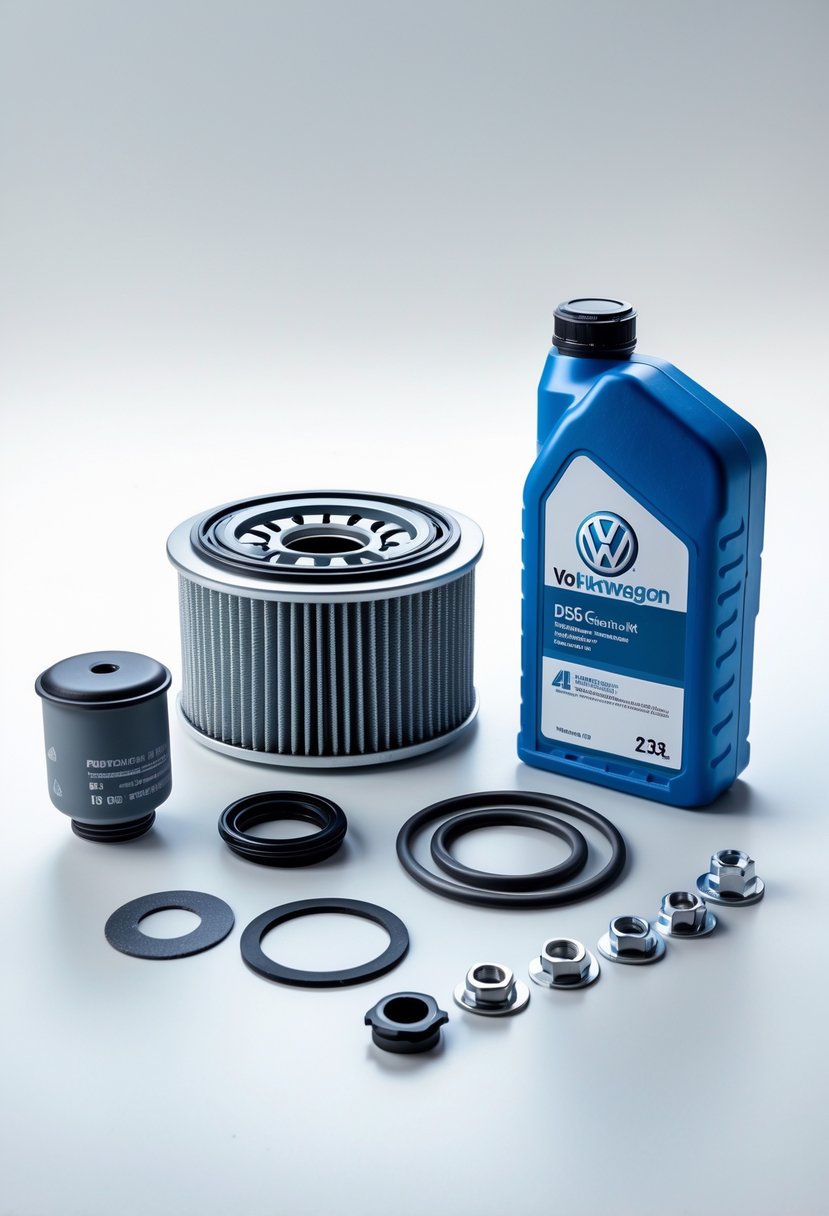
Many Volkswagen models with a DSG require service every 40,000 miles, making the right kit an important part of routine maintenance. These kits are designed to match the exact needs of the transmission, whether it’s a 6-speed wet-clutch or a 7-speed dry-clutch unit. Choosing a kit that meets OEM standards supports long-term reliability and performance.
Understanding what’s inside a DSG service kit, how it’s used, and when to use it can make the difference between smooth driving and expensive repairs. With the right information, owners can select a kit that fits their vehicle and keep the transmission operating as intended.
What Is a VW DSG Transmission Service Kit?
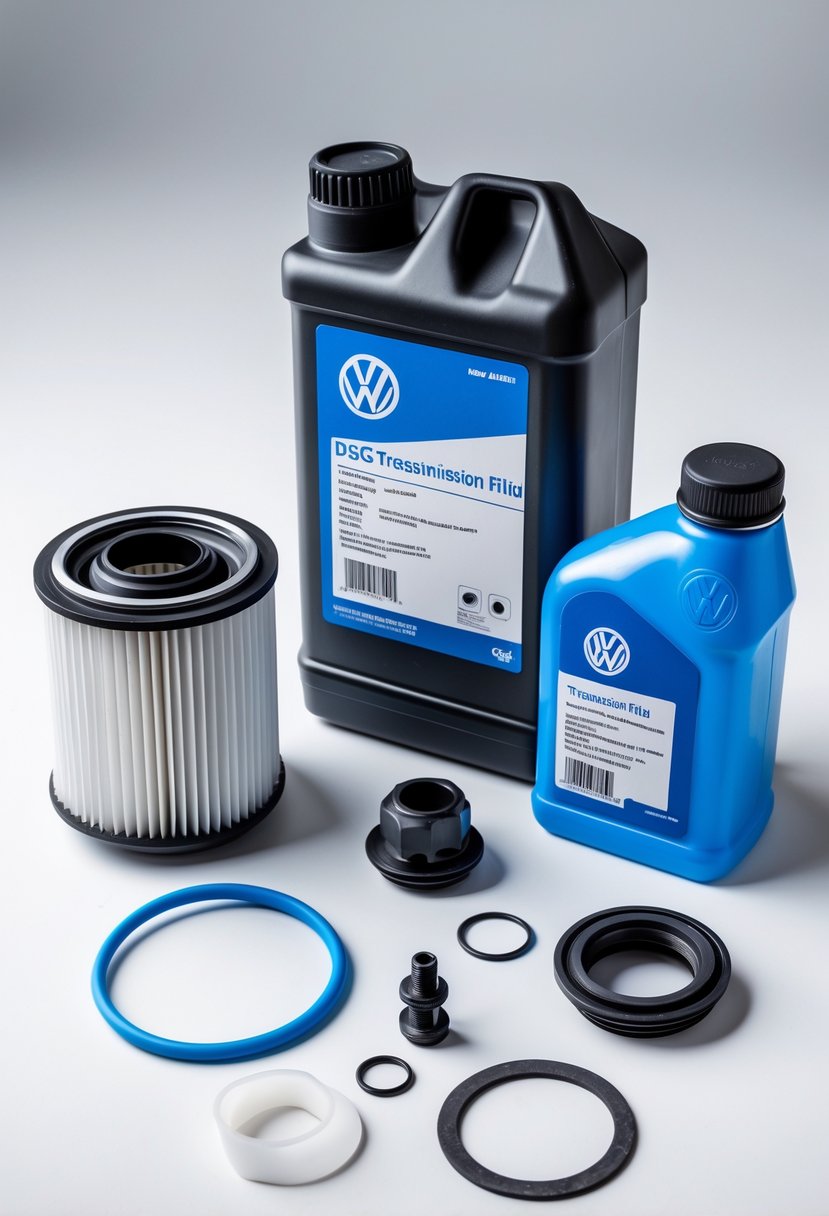
A VW DSG transmission service kit contains the specific parts needed to maintain a Volkswagen Direct Shift Gearbox. It is designed for the unique requirements of the DSG system, which combines elements of both manual and automatic transmissions. Using the correct kit helps ensure smooth gear changes and prevents premature wear.
Core Components Included
A typical DSG transmission service kit includes DSG-specific transmission fluid, a transmission filter, and seals or washers for proper reassembly.
Most kits provide around 5–6 liters of fluid, matching Volkswagen’s specifications for a full service. The fluid is formulated for the DSG’s dual-clutch design, which operates under different pressures and heat levels than a standard automatic.
The kit usually contains:
| Component | Purpose |
|---|---|
| DSG Fluid | Lubricates and cools gears and clutches |
| Filter | Removes metal particles and debris |
| O-ring | Seals the filter housing |
| Sealing Washer | Prevents leaks at the drain or fill plug |
Some kits also include a drain plug, fluid level tube, or specialty tools, which can make the service process easier and more accurate.
Purpose and Importance
The DSG transmission relies on clean, properly formulated fluid to operate its clutches and hydraulics. Over time, fluid breaks down and collects contaminants, which can cause rough shifting or delayed engagement.
Replacing the filter helps keep the internal components free of debris. The seals and washers prevent leaks that could lead to low fluid levels and potential damage.
Regular servicing with the correct kit maintains consistent shift quality and supports the DSG’s complex electro-mechanical system. Volkswagen generally recommends servicing every 40,000 miles, though more frequent service may be needed for harsh driving or towing.
Skipping service can result in higher repair costs, as DSG components are more sensitive to fluid condition than many standard automatics.
Differences from Standard Transmission Kits
A DSG service kit is different from a conventional automatic transmission kit because the DSG is a dual-clutch automated manual. It uses two separate clutches for odd and even gears, requiring a specific fluid type and filter design.
Standard automatic kits often use ATF (automatic transmission fluid), which is not compatible with DSG systems. DSG fluid has distinct friction and heat resistance properties tailored to the gearbox’s wet-clutch design.
The filter in a DSG kit is also designed for its unique housing and oil flow path. Using a non-DSG kit can cause improper lubrication or filtration, leading to performance issues.
For this reason, only kits labeled for VW DSG or Direct Shift Gearbox should be used during maintenance.
Key Parts and Tools in the DSG Service Kit
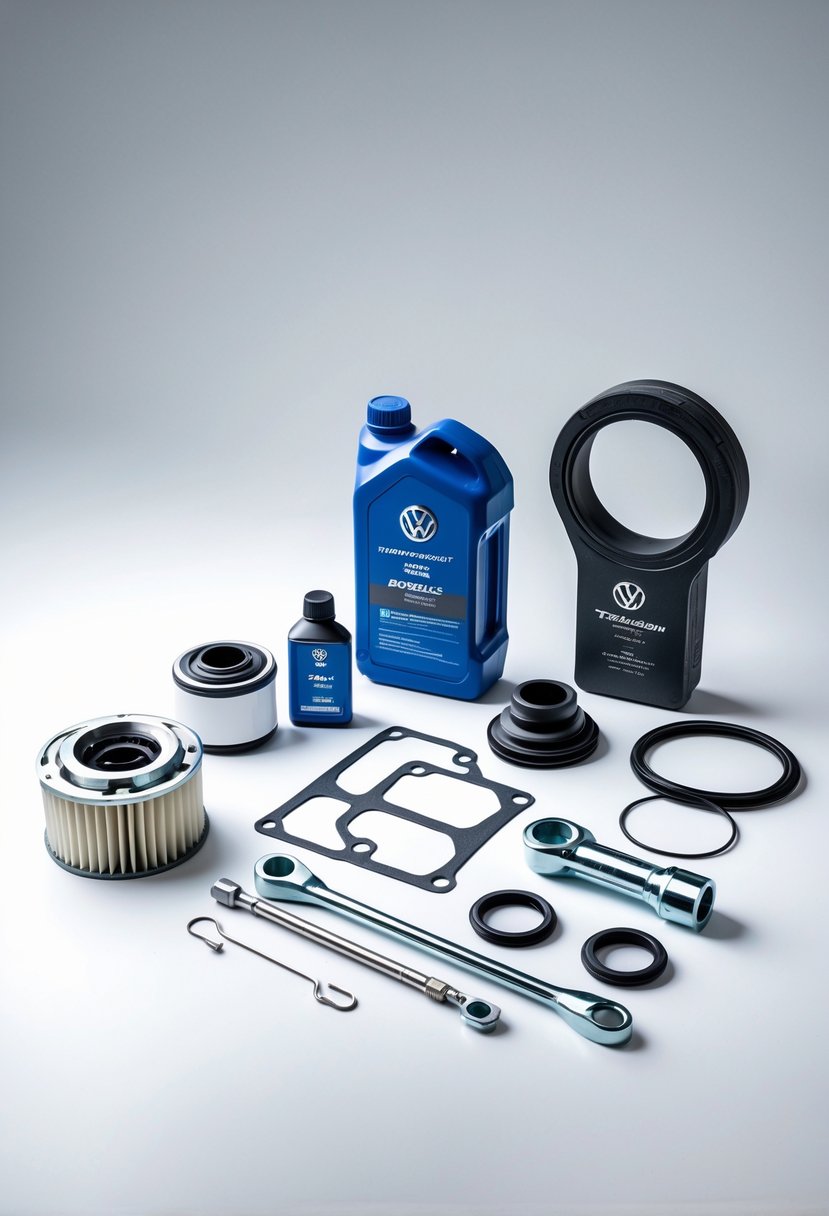
A DSG service kit contains specific parts and tools needed to change the transmission fluid and filter on Volkswagen and Audi vehicles with a Direct-Shift Gearbox. Each item serves a defined purpose to ensure correct fluid replacement, proper sealing, and reliable operation after the service.
DSG Fluid and Approved Brands
DSG transmissions require a specific type of fluid that meets factory specifications such as VW G 052 182 A2. Using the wrong fluid can cause shifting issues and premature wear.
Common approved brands include Liqui Moly, Pentosin FFL-2, Febi-Bilstein, and Fuchs. Most DSG services need about 5.2–5.5 liters of fluid, though many kits include six 1-liter bottles to ensure enough supply.
The fluid must handle high heat and maintain consistent viscosity for smooth gear changes. It also contains friction modifiers designed for the DSG’s wet clutch system.
When choosing fluid, it is important to verify the product label for VW approval codes. Mixing brands or using non-approved fluid can lead to transmission damage.
DSG Filter and Gasket
The DSG filter removes fine metal particles and debris from the fluid. Over time, these contaminants build up and can affect hydraulic control and clutch performance.
Most kits include an OEM-style DSG filter (such as part number 02E 305 051 C) along with a new O-ring gasket. The gasket ensures a tight seal between the filter housing and the transmission case.
Replacing the filter at each fluid change is recommended because the DSG’s internal components rely on clean, unrestricted fluid flow.
A damaged or worn O-ring can cause leaks, leading to low fluid levels and potential gearbox damage. Always lubricate the new O-ring lightly with DSG fluid before installation to prevent pinching.
Drain Plug Washer and Drain Plug Allen Socket
The drain plug washer (often copper or aluminum) seals the drain plug against the transmission case. It should be replaced every time the plug is removed to prevent fluid leaks.
Some kits also include a new drain plug, though many services reuse the original if it is undamaged.
To remove and install the plug, a DSG drain plug Allen socket is required. This is usually a 14mm hex bit socket, which fits the recessed plug design.
Using the correct socket prevents rounding or damaging the plug head. A torque wrench should be used during reinstallation to meet the manufacturer’s specified torque setting.
DSG Oil Fill Tool
The DSG oil fill tool allows fluid to be pumped or gravity-fed into the transmission through the correct fill port. DSG gearboxes cannot be filled like a standard automatic transmission.
This tool often attaches directly to the fluid bottles or uses a hose and adapter to connect to the fill opening. Some kits include a threaded adapter that locks into the port for a secure fit.
Filling the DSG requires the vehicle to be level and the fluid temperature monitored with a diagnostic tool. The fill tool helps control the flow rate and reduces the risk of spills.
Without the proper fill tool, it is difficult to add the exact amount of fluid and complete the service correctly.
Step-by-Step DSG Transmission Service Process
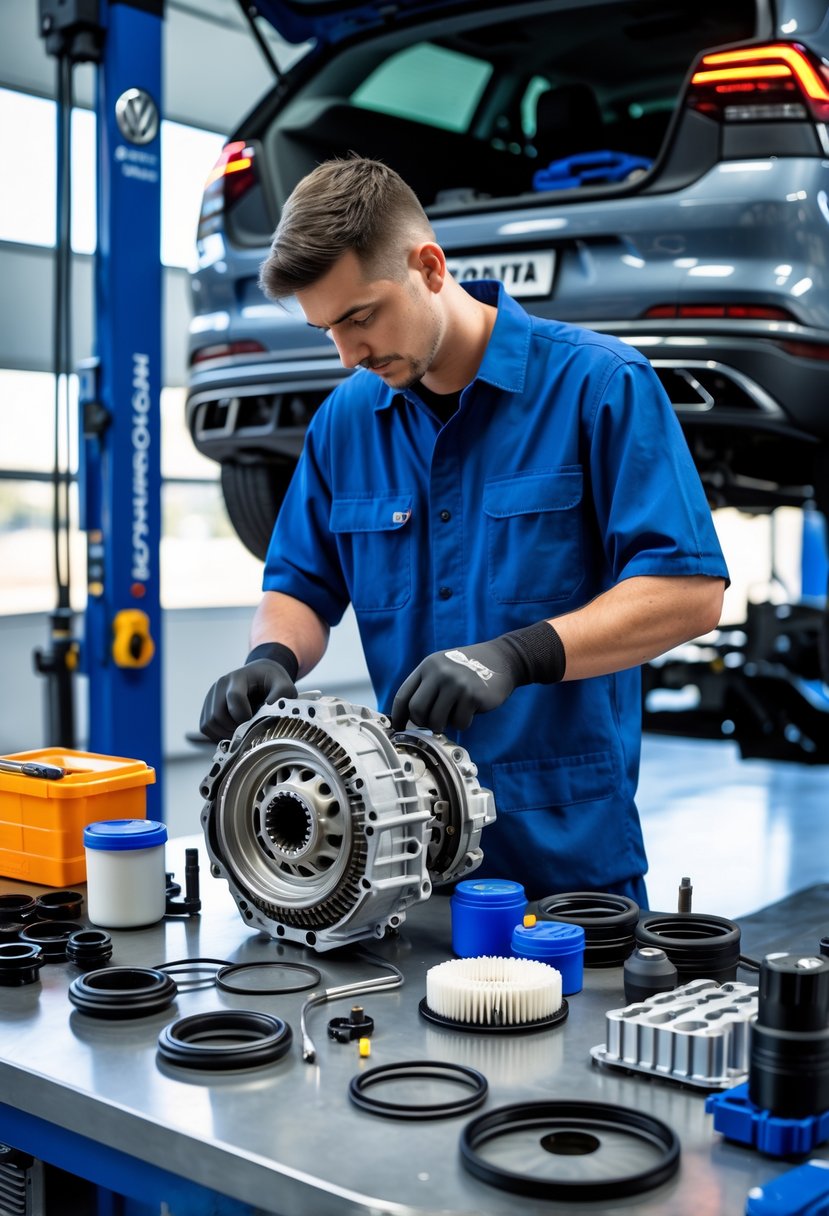
A proper DSG transmission service involves draining the old fluid, replacing the filter, refilling with the correct specification oil, and setting the fluid level at the right temperature. Using the correct tools and following precise steps helps maintain smooth gear shifts and prevents premature wear.
Preparation and Required Tools
The vehicle should be parked on a level surface with the parking brake engaged. If using a jack, secure it with axle stands before working underneath.
Essential tools include:
| Tool / Item | Purpose |
|---|---|
| 24mm socket | Remove DSG filter housing |
| 8mm Allen socket | Remove overflow tube |
| 14mm Allen socket | Remove drain plug |
| Torque wrench | Tighten components to spec |
| Fluid filling tool | Add DSG oil |
| OBDeleven scan tool | Monitor fluid temperature |
They should also have nitrile gloves, shop rags, and a large drain pan for 5–6 liters of used fluid. The correct DSG oil and a new filter with O-ring are required.
Draining and Refilling DSG Fluid
With the car safely lifted, place the drain pan under the transmission. Remove the main drain plug using the 14mm Allen socket.
If the gearbox has an internal overflow tube, remove it with the 8mm Allen socket to release the remaining fluid. Let the oil drain fully before reinstalling the overflow tube.
Using the filling tool, pump in fresh DSG fluid that meets the correct VW specification. Most DQ250 6-speed units require about 5.5–6 liters. Keep the car level during filling to ensure an accurate fluid amount.
Replacing the DSG Filter
The DSG filter housing is often located on top of the transmission, usually under the airbox. Remove any components blocking access, such as intake hoses or covers.
Unscrew the filter cap using the 24mm socket. Pull out the old filter and allow residual oil to drain back.
Replace the O-ring on the cap with a new one, lightly coating it with fresh DSG oil. Install the new filter, thread the cap by hand, and torque it to the manufacturer’s specification (commonly 20 Nm).
Setting DSG Fluid Level with OBDeleven Scan Tool
The DSG fluid level must be set with the oil at the correct temperature, usually 35°C to 45°C. The OBDeleven scan tool connects to the vehicle’s OBD-II port to read live transmission fluid temperature.
With the engine running and the transmission in park, monitor the temperature. Once it reaches the correct range, open the level plug. Excess fluid will drain until it drips steadily.
Tighten the plug to the specified torque (often 45 Nm). This ensures the gearbox has the correct fluid level for smooth operation.
Recommended Service Intervals and Vehicle Compatibility
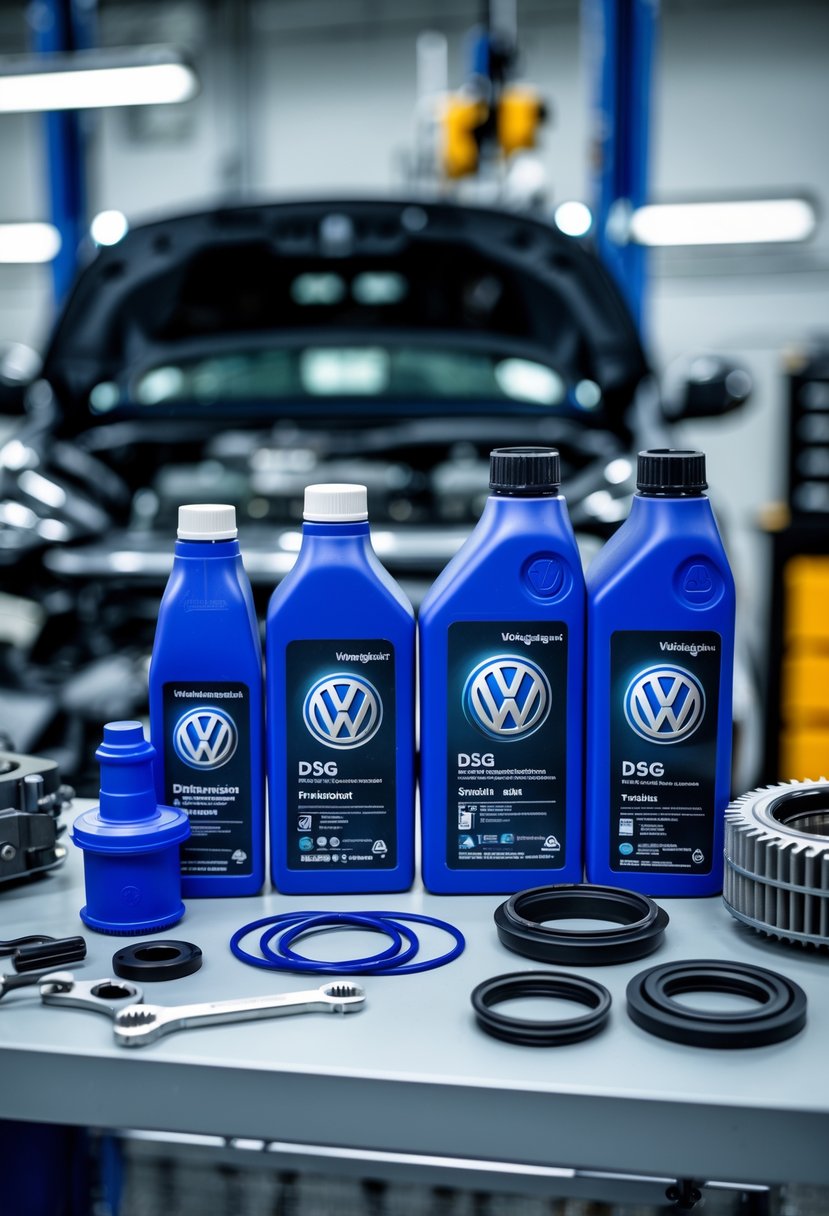
Most Volkswagen and Audi vehicles with a DSG transmission require service at specific mileage intervals to maintain smooth shifting and prevent wear. Service kits are designed to match the fluid type, filter, and seals specified for each gearbox version to ensure proper fit and performance.
Volkswagen and Audi Models Covered
DSG transmissions are used in many Volkswagen models, including the Golf, Passat, Jetta, Tiguan, and Arteon. Audi models such as the A3, S3, TT, and some A4 and Q3 variants also use DSG gearboxes.
There are multiple DSG versions, such as the 6-speed wet-clutch DQ250 and the 7-speed dry-clutch DQ200. Each has different fluid requirements and service intervals.
A correct transmission service kit will specify compatibility by model, year, and gearbox code. Owners should confirm the gearbox type, as using the wrong oil or filter can cause shifting problems or damage.
High-performance models like the Audi S4 or VW Golf R may require higher-grade fluids or more frequent servicing due to increased heat and load.
TDI Engines and DSG Service
Many TDI diesel models use the 6-speed wet-clutch DSG. These gearboxes typically require service every 40,000 miles. The interval is the same for both diesel and gasoline versions when using the same gearbox type.
TDI engines produce higher torque at lower RPM, which can place more stress on the clutch packs. This makes proper lubrication and clean filtration especially important.
A DSG transmission service kit for TDI models usually includes:
| Component | Purpose | Typical Replacement Interval |
|---|---|---|
| DSG Fluid (OEM-spec) | Lubricates clutches and gears | 40,000 miles |
| DSG Filter | Removes debris from hydraulic fluid | 40,000 miles |
| Seals/Washers | Prevent fluid leaks | With every fluid change |
Skipping service on a TDI DSG can lead to premature clutch wear or mechatronic faults.
Warranty and Maintenance Records
Following the manufacturer’s service schedule is important for keeping warranty coverage intact. Volkswagen and Audi often require proof of DSG maintenance at the correct intervals for warranty claims involving the transmission.
Owners should keep detailed service records, including receipts for the transmission service kit and labor. This documentation can be from a dealership or qualified independent shop.
If the vehicle is still under a powertrain warranty, using OEM-approved DSG fluid and parts is recommended. Aftermarket kits may be acceptable if they meet the same specifications, but proof of compatibility is important.
Neglecting scheduled DSG service can result in denied warranty claims if transmission issues arise later.
Choosing the Right DSG Service Kit for Your VW
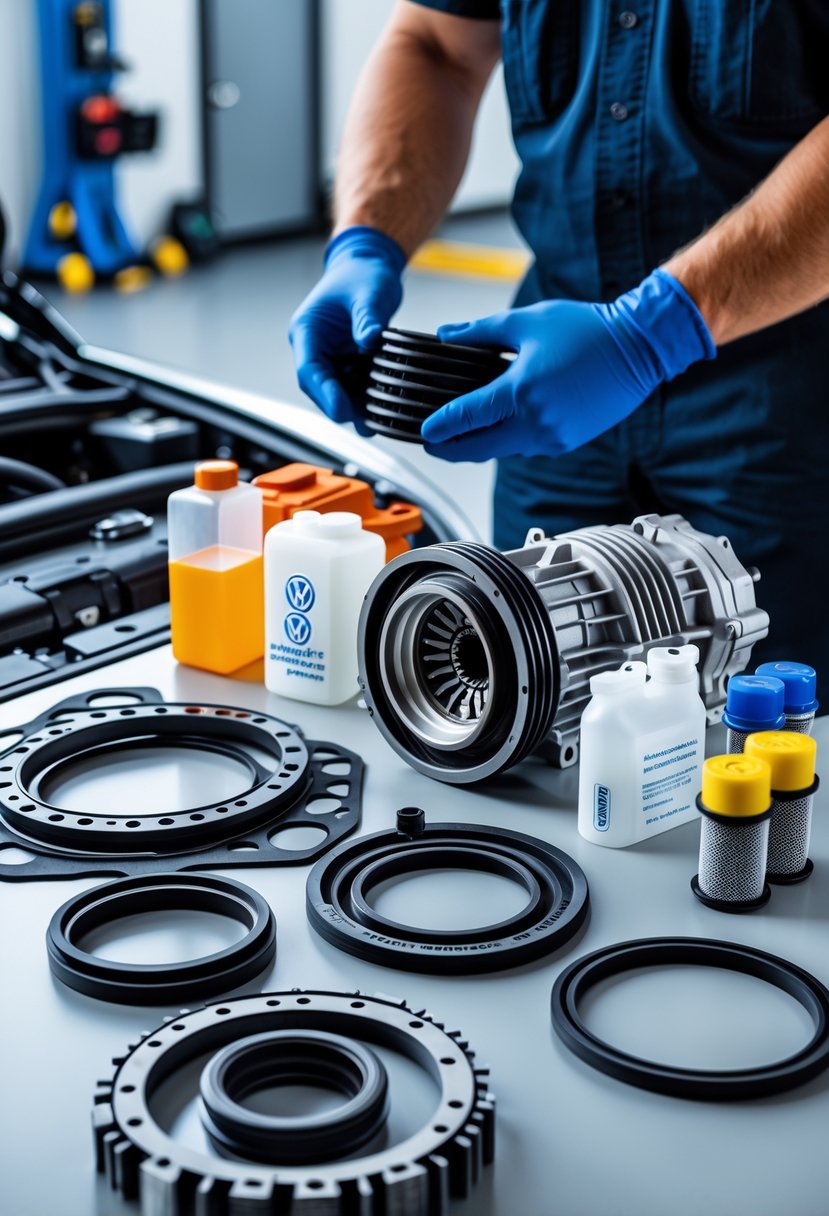
The right DSG service kit should match the exact transmission model, use the correct fluid type, and include all required parts for a complete service. Selecting the wrong kit can lead to poor shifting, transmission wear, or fluid leaks. Quality, compatibility, and proper specifications matter more than brand name alone.
OEM vs Aftermarket Kits
OEM (Original Equipment Manufacturer) kits use the same parts and fluids that Volkswagen installs at the factory. They often include factory-approved DSG fluid, a new filter, seals, and a drain plug washer. These kits ensure compatibility but can cost more.
Aftermarket kits may use parts from brands like Liqui Moly or Febi-Bilstein. They can meet or exceed OEM specifications while offering lower prices. Some also include extra tools, such as a DSG oil filler adapter, that OEM kits may not provide.
When choosing between OEM and aftermarket, buyers should compare:
| Factor | OEM | Aftermarket |
|---|---|---|
| Price | Higher | Often lower |
| Warranty | Matches VW specs | Varies by brand |
| Fluid Type | VW-approved | May be VW-approved or equivalent |
| Extras | Basic parts | May include tools or options |
If the vehicle is still under warranty, OEM kits are usually the safer choice. For out-of-warranty cars, high-quality aftermarket kits can be cost-effective without sacrificing performance.
Selecting the Correct Fluid and Parts
The DSG uses a specific fluid formula that differs from standard automatic transmission fluid. Using the wrong fluid can cause shifting problems or damage. Common approved fluids include VW G 052 182 A2 and equivalents from Liqui Moly or Pentosin.
A proper DSG service kit should include:
- DSG fluid (usually 5.5–6 liters)
- DSG filter
- O-ring seal
- Drain plug washer
Some kits also include a filler tool for gravity or pressure filling. Buyers should confirm the fluid type matches their VW’s transmission code, such as DQ250 or DQ381. Checking the owner’s manual or service manual before purchase avoids costly mistakes.
Tips for Ensuring Proper Fitment
Not all DSG transmissions use the same filter size or fluid capacity. The kit must match the exact transmission model and year.
Before ordering, the buyer should:
- Identify the transmission code from the vehicle’s build sheet or service records.
- Verify the fluid specification required.
- Check whether the kit includes all seals and washers needed.
Some VW models require special tools for filling, such as a DSG fluid adapter. If the kit does not include this, it must be purchased separately. Ensuring fitment before service prevents delays and avoids using incompatible parts.
Frequently Asked Questions
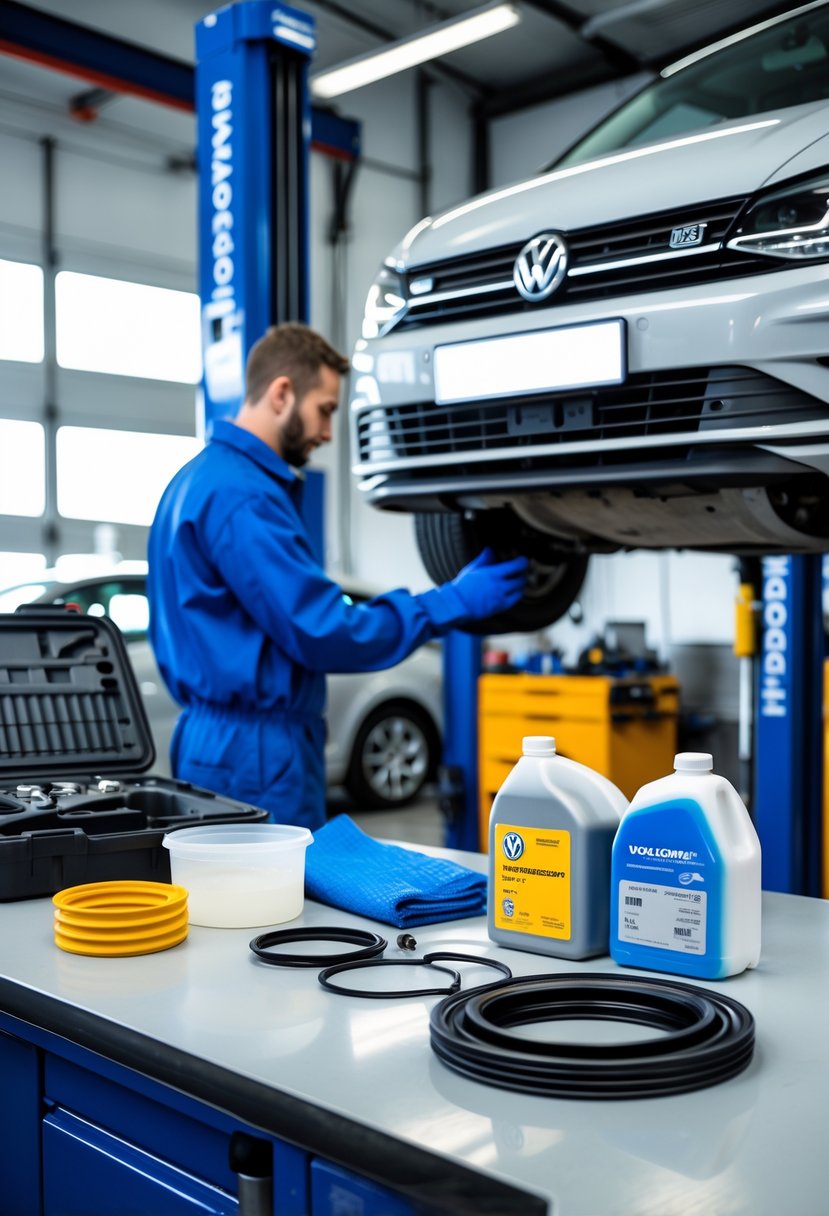
A VW DSG transmission service uses specific parts, fluids, and tools to maintain smooth shifting and prevent wear. Service intervals, kit compatibility, and correct procedures are important to ensure proper function and avoid costly repairs.
What is included in a typical DSG service kit?
Most DSG service kits include DSG-specific transmission fluid, a transmission filter, and seals or washers for reassembly.
Some kits also include a drain plug, fluid level tube, or other small hardware. The exact contents can vary by supplier and vehicle model.
How often should a DSG transmission be serviced?
Volkswagen recommends servicing most DSG transmissions every 40,000 miles.
In harsh driving conditions, such as frequent stop-and-go traffic or towing, the service may be needed as early as 30,000 miles.
Can I use third-party service kits for my VW DSG transmission?
Yes, third-party kits are available from various suppliers.
It is important to ensure the kit meets OEM specifications for fluid type, filter design, and seals to avoid performance or reliability issues.
What are the steps involved in servicing a DSG transmission?
The basic process includes draining the old fluid, replacing the filter, installing new seals or washers, and refilling with the correct amount of DSG fluid.
A fluid level check is done at a specific temperature using a level tube. Some steps require diagnostic tools to monitor transmission temperature.
Are there specific service kits for different DSG transmission models?
Yes, DSG transmissions come in different versions, such as the 02E 6-speed and DQ381 7-speed.
Each version requires a kit with the correct filter, seals, and fluid capacity for that model.
What tools are required to perform a DSG transmission service?
Common tools include a hex bit socket for the drain plug, a fluid pump or filler tool, and a diagnostic scanner to read transmission temperature.
Some models also require a fluid level tube for proper filling and measurement.

![Volkswagen Jetta Headlights Not Working [How To Fix]](https://volkswagenbuddy.com/wp-content/uploads/2024/05/volkswagen-jetta-headlights-not-working-how-to-fix_3878-768x531.jpg)
![Volkswagen Engine Code Location [Answered]](https://volkswagenbuddy.com/wp-content/uploads/2024/05/volkswagen-engine-code-location-answered_4169-768x531.jpg)


![2000 Volkswagen Jetta Engine Codes P0117 [Answered]](https://volkswagenbuddy.com/wp-content/uploads/2024/05/2000-volkswagen-jetta-engine-codes-p0117-answered_4195-768x531.jpg)
